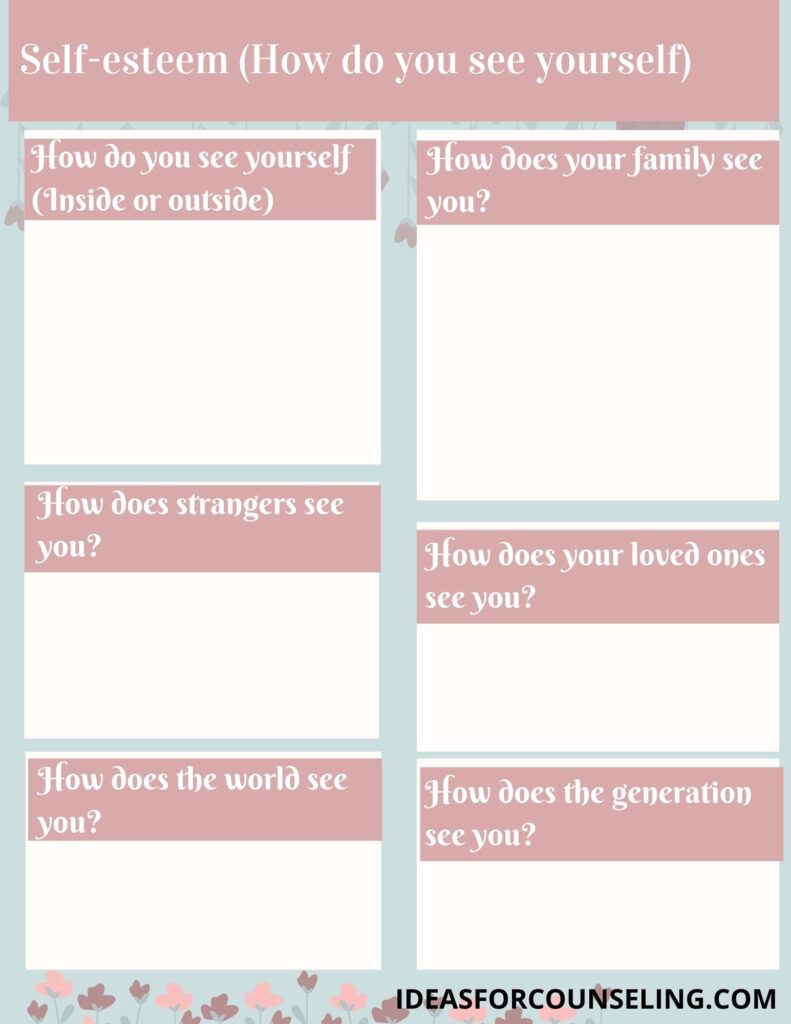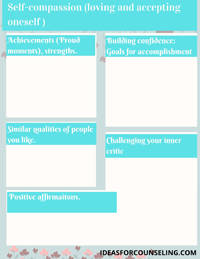COMMUNICATION
There are tons of psychoeducation handouts for communication skills out there. Here are some of my favorite ones.
- Types of Communication Via Psychology Tools: The different types of passive, assertive, and aggressive communication. https://www.psychologytools.com/resource/assertive-communication/
- I statement and assertive communication from therapist aid: It teaches how you can use assertive communication. https://www.therapistaid.com/tools/communication/none

So, I will definitely recommend doing communication activities with family members like discussed in the previous session, it becomes more practical and theoretical.
SELF ESTEEM
As for self-esteem, this is my favorite part. It is always fun to change the way patients see themselves. It becomes a little easier if they were able to figure out their belief system from previous CBT-focused sessions. I have two worksheets focused on self-esteem.
1st worksheet focused on exploring what affects the way they see themselves:

- How do you see yourself (Inside or outside)? I love talking about how we live in a world where we are probably more judgemental to ourselves than others are to us. I also discuss differences between inside qualities and emphasize society places (kind, compassionate, loving, hardworking), and outside (beautiful, skinny, skin color). The inner critic is so much more alive and recurring than the outer critic. The words might start with the outer critic, but the inner critic just plays the words over and over again.
- How does your family see you? : This can be a good time to talk about how the patient has unique physical features because of family history, genes, and origins. I also love having a conversation about how the world would look if everyone looked the same. For example, everyone looked like Justin Bieber or Ariana Grande.
- How do strangers see you when they look at you? This can bring up conversation and revision about cognitive distortions and restructuring. Can we read these strangers’ minds? Is it really going to matter in a week, 5 days, 5 months, or 5 years?
- What do you think your loved ones see you (partner, friends, and family that care about you)? This topic really opens up the eyes of the kids. People truly love and care for you for who you are regardless of your strengths and weaknesses. The importance is the connection between two souls than how they look or act.
- How does your generation, school setting, peers, and bullies want you to see yourself? We started googling and looking up the dress, hairstyles, and celebrities of different generations, and how things change over time. I also talk about how It is easier to make cliques and groups and bully others who are not the same as the group or clique. This brings up a conversation about who decides what is beauty.
- How does society, the world, social media, and pop culture want you to see yourself? This kind is similar to number 5, and similar kinds of conversations.

SELF COMPASSION
2nd worksheet focused on challenging and changing the way you see yourself: This worksheet is focused on improving your self-respect and loving and accepting yourself.
- Challenging your inner critic: First thing comes the observation, and then comes acknowledging them and choosing to either reframe/ change/challenge it. There is always the other one where you can accept it as your weakness.
- Similar qualities of people who you like: We are always attracted to people who are kind, and loving, are able to achieve happiness with others and themselves, and love us for who we are. So, it becomes easier for people to recognize their loved one’s qualities than their own. We tend to be harsher on ourselves (only seeing the negative rather than the positive attitude or qualities). So, this can help an individual to find those inner human nature.
- Achievements or proud moments: Recognizing that there is no such thing as a perfect human being, and how each individual has different weaknesses and strengths. Sometimes, having a discussion about the difference between pride and boasting. Pride is a feeling of self-respect, being satisfied with one’s achievements, and boasting is glorifying oneself to others.
- Building confidence: Goals that can be accomplished: Self-criticism or weaknesses can be seen as a motivator to be healthier (healthier interaction with others, healthy living, healthy thinking, and healthy actions). Loving oneself to encourage and support oneself will be the key.
- Positive affirmations: To improve the way you are speaking to yourself (inner dialogue and mindset) can really help improve self-respect. Encouraging oneself through words can really help the kids remember to use them when they need them.

